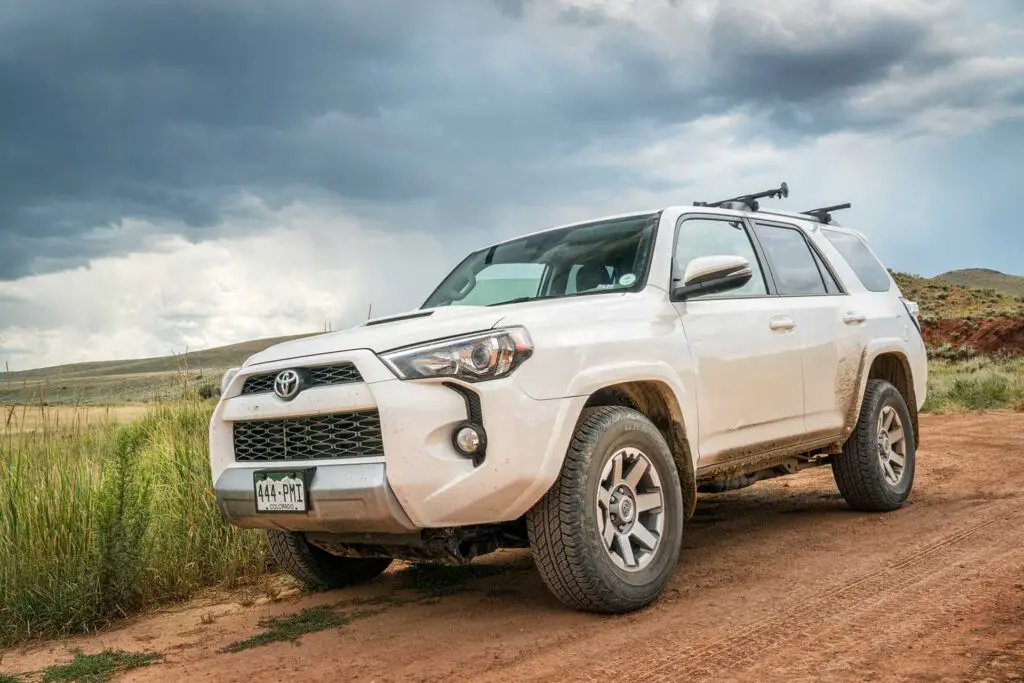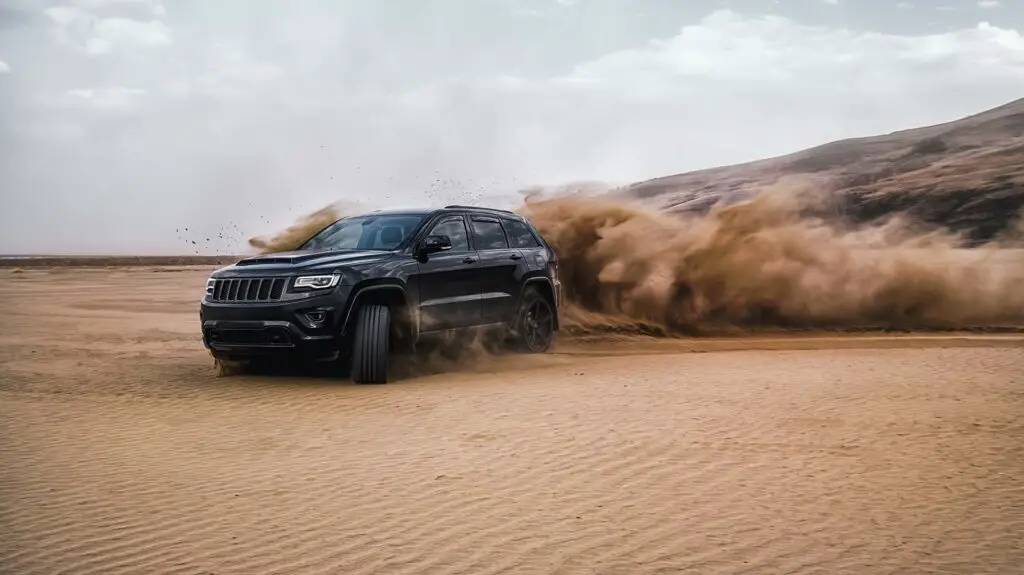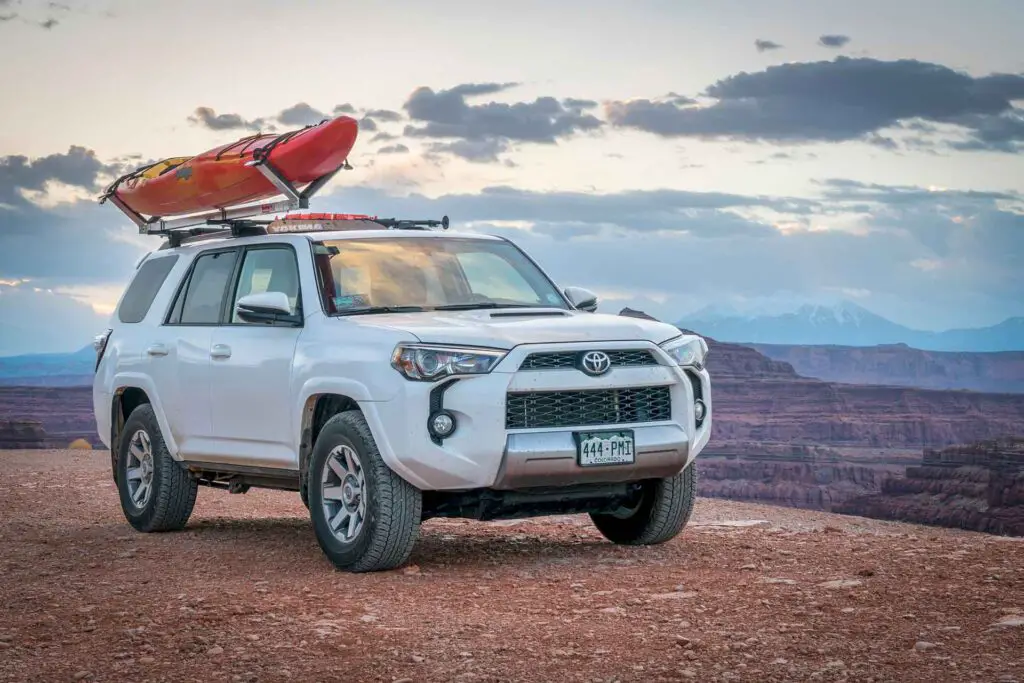In the category of mid-size SUVs, there’s an age-old debate – Jeep Grand Cherokee vs. Toyota 4Runner. Both are titans in the world of SUVs, each boasting its cult following and a laundry list of perks. But which one truly reigns supreme when they go head-to-head? Let’s dive into this ultimate showdown and see how these legends stack up.
While the Jeep stands out with its power options, handling, and fuel efficiency, the 4Runner has an edge in affordability and cargo space. Ultimately, your choice hinges on personal priorities – budget and storage or power and driving experience. Either way, both vehicles promise a reliable adventure companion.
These Two Models Are Some of the Most Popular Mid-Size SUVs in Today’s Market
Mid-size SUVs offer the perfect blend of versatility, power, and practicality. First things first, they are the perfect family vehicles, especially for those who enjoy road trips on the famous routes in the US from time to time.
Secondly, these SUVs are not your typical rugged, off-road driving vehicles – they are also suitable for city roads. Usually boasting good fuel efficiency and reasonable ownership costs, the versatility and practicality brought to the table have made mid-size SUVs a top choice among drivers worldwide. Recognizing the immense potential in this category, both Jeep and Toyota have made significant entries.
The 4Runner Has Been Making Strides Ever Since the ‘80
Toyota unveiled the 4Runner in 1984, marking the birth of an SUV that would soon become a favorite around the world, spanning over five generations. While in Japan, it gained fame as the Hilux Surf, it was discontinued in 2009 on its home market.
However, this particular model has been a staple on American roads for decades, and not only in the form of used vehicles. Recently, amidst the buzz around the latest Land Cruiser and Grand Highlander reveals, the brand dropped hints about a revamped 4Runner coming soon.
As for now, here are the trim levels available for the last model years:
- Limited,
- SR5,
- SR5 Premium,
- TRD Off-Road,
- TRD Off-Road Premium,
- TRD Pro,
- TRD Sport.
The Grand Cherokee Is a Testament to the Brand’s Adaptability Over the Decades
The Jeep’s answer to the mid-size SUV competition entered the scene a few years later at the 1992 North American International Auto Show in Detroit. Despite being the younger of the two competitors, it’s also seen a vehicle evolution over five impressive generations.
Ever since its debut, the model became an emblem of Jeep’s dynamic adaptability. Its key competitor, the Ford Explorer, was undeniably popular, but this model brought something unique to the table – a distinct unibody design. This set it apart from the traditional body-on-frame structure that many of its contemporaries, like the Explorer, sported.
Cut to today, and this four-wheeler is still going strong, with the 2024 model year starting production in November. Here are the available trim level options:
- Laredo,
- Altitude,
- Limited,
- Overland,
- Summit,
- Summit Reserve.

The Grand Cherokee Boasts a Recently Redesigned Exterior Styling
The 2022 model year brought exciting changes for the Jeep’s four-wheeler, which underwent a comprehensive revamp, both inside and out. On the other hand, Toyota’s SUV remained mostly consistent in its design.
The past few years haven’t seen groundbreaking aesthetic shifts for the 4Runner, with a special trim level introduced in 2021 being a notable exception. That, coupled with the introduction of LED headlights as a standard feature, basically sums up all recent design tweaks.
The Winner of This Category Comes Down to Personal Taste
Diving deeper into the exteriors, the Grand Cherokee exudes a sense of rugged sophistication with its sharp lines, bold grille, and a stance that speaks of capability. The 4Runner, while maintaining its classic design, commands respect with its robust build, emphasizing endurance and adventure.
Both vehicles, though distinctive in appearance, capture the essence of what an SUV should represent. Ultimately, who takes the crown in the looks department boils down to individual taste. No choice is wrong – it’s all about what resonates with you.

Jeep Grand Cherokee vs. Toyota 4RUNNER – A Comprehensive Size Comparison
If you’re browsing the SUV landscape, then size undoubtedly ranks high on your list of priorities. After all, isn’t the essence of this category to offer spaciousness without compromising on style? Before we take a closer look into how these four-wheelers use up their respective interior spaces, here’s a size comparison:
| Measurement | 2023 Laredo Grand Cherokee | 2023 Limited 4Runner |
| Height | 70.8 in | 71.5 in |
| Length | 193.5 in | 190.7 in |
| Width | 77.5 in | 75.8 in |
| Wheelbase | 116.7 in | 109.8 in |
| Seating Capacity | 5 | 5 |
| Cargo Space | 37.7 cu/ft | 47.2 cu/ft |
Both Mid-Size SUVs Have an Optional Third-Row
At their base trim levels, both of these mid-size SUVs offer seating for five. However, if you’re seeking that extra row, both brands have got you covered. Jeep brings to the table the Grand Cherokee L, extending seating capabilities amidst other performance upgrades. Meanwhile, the Toyota is not far behind – those keen on having an extra row in the back can opt for the SR5, SR5 Premium, or Limited trims.
The 4Runner Offers Much More Cargo Space
When it comes to cargo capacity, the Jeep offers a respectable 37.7 cubic feet behind its second row. When those seats are folded down, this space amplifies to 70.8 cubic feet.
In contrast, the two-row Toyota flexes its spacious muscles with a generous 47.2 cubic feet, which transforms into a vast 89.7 cubic feet of space with the seats folded down. This makes it a clear winner in the category, with an advantage of nearly 20 additional cubic feet compared to its contender.

Which SUV Offers More Infotainment Features as Standard?
In an increasingly connected world, the infotainment system of a vehicle has rapidly climbed the ranks of priority for modern drivers. It’s no longer just about getting from point A to point B – it’s about enjoying the journey, staying informed, and remaining connected. So, let’s see which one of these mid-size SUVs truly excels in delivering top-notch infotainment features out of the box.
The Standard Infotainment Features of the Grand Cherokee
Here’s what you can expect from the Jeep’s Uconnect 5 infotainment system as standard features:
- An 8.4-inch touchscreen display,
- Apple CarPlay,
- Android Auto,
- Bluetooth,
- A Wi-Fi hot spot,
- Two USB ports,
- Six-speaker audio system.
The Standard Infotainment Features of the 4Runner
On the flip side, here are the infotainment features that Toyota brings to the table as standard:
- An 8-inch touchscreen display,
- Apple CarPlay,
- Android Auto,
- Amazon Alexa,
- Bluetooth,
- A Wi-Fi hot spot,
- Three USB ports,
- Voice recognition,
- Satellite radio,
- Eight-speaker audio system.
All in all, it appears that this four-wheeler has a slight edge in this realm, consistently offering a well-equipped infotainment package across its base models. However, when it comes to the technology itself, Jeep’s excellent Uconnect 5 system is lightyears ahead. Sure, you’ll need to climb up the trim level ladder to get more features, but the infotainment system is much more advanced.

How Do They Compare When It Comes to Safety Features?
While a state-of-the-art infotainment system might be the cherry on top, at the heart of every vehicle purchase should be a consideration for safety, the number one driver’s responsibility. The blend of comfort and security is essential, especially if you’re looking for your next family car, as it provides peace of mind in navigating city streets and winding country roads.
Luckily, both of these mid-size SUVs offer a wide range of safety features, including the following:
- Blind-spot monitoring,
- Forward collision warning,
- Forward automatic emergency braking,
- Lane-departure warning,
- Lane-keep assist,
- Rear cross-traffic alert,
- Rearview camera.
The Safety Ratings of the 2023 Model Years Are Still Not Available
As of now, top safety institutions have yet to release extensive reviews for the 2023 model years of these vehicles. However, it’s worth noting that previous model years of both have not raised any significant red flags. History suggests a commitment to safety, although it’s always prudent to keep an eye out for the latest evaluations to ensure the highest standards are met.
Toyota 4RUNNER vs. Jeep Grand Cherokee – Power, Handling, and Fuel Efficiency
Now, this is the moment you’ve been probably waiting for. Strip away the shiny bells and whistles, the cutting-edge tech, and the plush interiors, and you’re left with what many argue is the soul of the vehicle – its performance on the road.
First things first, let’s take a brief look at what each of these mid-size SUVs has to offer:
| Specification | 2023 Laredo Grand Cherokee | 2023 Limited 4Runner |
| Engine | 3.6L 6-cylinder engine | 4L 6-cylinder engine |
| Horsepower | 293 hp at 6,400 rpm | 270 hp at 5,600 rpm |
| Torque | 260 lb/ft at 4,000 rpm | 278 lb/ft at 4,400 rpm |
| Transmission | 8-speed shiftable automatic | 5-speed shiftable automatic |
| Drivetrain | Four-wheel drive (4WD) | Rear-wheel drive (RWD) |
| Fuel Economy | 19/26/22 MPG | 16/19/17 MPG |
Now that we know the basics let’s see how these vehicles truly stack up in terms of raw power, nimble handling, and that ever-crucial fuel efficiency:
Engine Power
Jeep’s base model is powered by a Pentastar 3.6L V6 engine, boasting 293 horsepower and 260 lb/ft of torque. For the real adrenaline junkies, the special Trackhawk variant features a turbocharged V8 engine, pushing out a whopping 707 horsepower.
In contrast, every 4Runner is equipped with a consistent 4L V6 engine that produces 270 horsepower and 278 lb/ft of torque. Although these specs are relatively comparable, the Grand Cherokee provides a broader range of power choices for its customers, and that’s not something you can easily overlook.
Handling and Towing
The Jeep is celebrated for its exceptional off-road capabilities, yet it also provides a smooth ride in urban settings. Regardless of the chosen trim or suspension, it consistently offers superior maneuverability. On the other hand, the Toyota boasts a 9-inch ground clearance, ideal for tackling tough off-road conditions. But when it comes to city drives, it can sometimes feel a bit bulky and lacks finesse.
If you’re considering an SUV for camping or boating trips, towing capacity becomes crucial. The Grand Cherokee offers a basic towing limit of 3,500 lbs and can max out at 7,200 lbs. In contrast, the 4Runner provides a towing capacity capped at 5,000 lbs. Clearly, when it comes to pulling power, the Jeepster takes the lead.
Fuel Economy
When it comes to fuel efficiency, Jeep has achieved something quite remarkable – this mid-size SUV boasts 19 MPG in the city and 26 MPG on the highway, as per EPA ratings. Choosing a stronger engine will naturally affect these numbers, yet they remain commendable for a vehicle of its size. In contrast, Toyota, with its default engine and drivetrain, doesn’t match up – it brings the same numbers as the V8 Trackhawk engine, which is not a good look.
Which Mid-Size SUV Is the More Budget-Friendly Choice?
The Toyota emerges as the more wallet-friendly option, especially when comparing similar models, like the TRD Pro and the Trailhawk. That being said, the somewhat outdated design, as well as the lower performance specifications, contribute to its lower price. And when it comes to warranty, both vehicles offer the same deal – a three-year/36,000-mile limited warranty, along with a five-year/60,000-mile offering.

Picking the Perfect SUV for Your Adventures
While the Jeep seems to take the lead in many categories, let’s not write off the Toyota just yet. At the end of the day, everyone’s needs are different. If you’re looking to save a little cash and have ample room for all those weekend getaways, the 4Runner might be more up your alley. However, if it’s power and features galore you’re after, then the Grand Cherokee is calling your name. Either way, both vehicles have their strengths – it’s all about what fits your lifestyle best.








